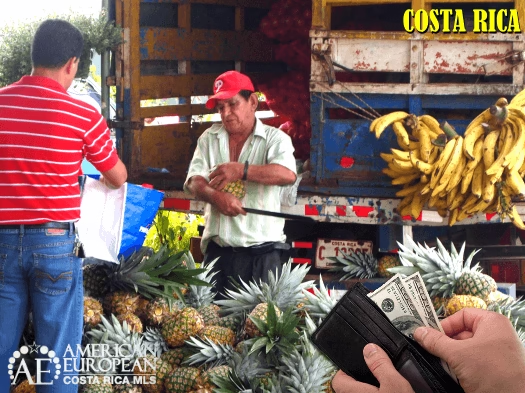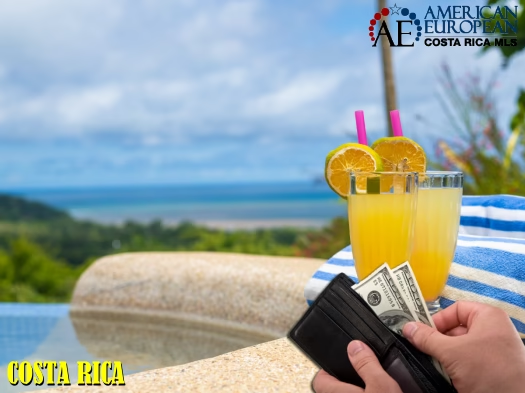Estimated Reading Time: 5 Minutes
Is the cost of living in Costa Rica high or not? In May 2022, the Tico Times published an article by Christopher Howard titled “Why is the cost of living in Costa Rica so high?” Christopher and I have both been here since the 80s, so we’ve seen the Colon go from ¢8,60 for 1US$, to around ¢500. This article explains what’s going on well.
Coming to Costa Rica from the US or Europe, you will find that the cost of living is about the same, and in some cases, even more. The cost of living in the beach area is more expensive than it is in the Central Valley. That’s because we don’t have many factories in Costa Rica, and almost everything is imported. Taxes on imported goods contribute to high prices. So shop local as much as possible, and you’ll see it’s not that bad. You can check a comparison between the US and Costa Rica on Numbeo, which gives you a pretty decent idea about the cost of living in Costa Rica.

How much to live on?
In 2025, this gives you, in my opinion, a good idea of how much you need to live on. This income is for two people and does not include rent, vacations, or car use. So, it doesn’t include education either.
- $2,500+/month: This income will allow you to eat, drink well, and go out for dinner once a week. You can afford good liquor as long as you don’t drink a bottle a day and shop for local and imported food products.
- $1,500/month: You will need to shop only local groceries (or made in a country with a commercial treaty), eat local meat, drink beer,
- $1000/month: Eat rice and beans three times a day, watch a local TV station (all Spanish), hop on the bus, don’t eat a lot of meat or change for an egg or two, and live a pretty laid-back lifestyle.
- Less than $1,000/month: you’d be living in the slums.
Housing Costs
Your cost of living in Costa Rica varies greatly depending on your housing. You can live in a single-family home for no additional cost than the rent. But if you want to live in a condo with amenities like a pool, the HOA fees will add another $200 – $1,000/month to your rent. Housing expenses in Costa Rica vary significantly depending on the location and your lifestyle. In the Central Valley, you will find rental prices higher in cities like Escazu and Santa Ana, prices in Tibas and Guadalupe are more affordable, and prices are lowest in Desamparados. The further away you are from San Jose, the more inexpensive the rent is. Finding long-term rentals (3 years) in the beach areas is challenging as homeowners receive a much better ROI on the short term at Airbnb and others.
You can check properties for sale on our MLS now to get a good idea of what a house costs anywhere in the country.

Food and Groceries
Grocery expenses in Costa Rica depend on dietary preferences and shopping habits. Locally grown fruits, vegetables, and staple foods such as rice and beans are inexpensive. However, imported goods, specialty items, and international brands are often more costly than in North America. Eating out at local sodas (small family-run restaurants) is affordable, with meals costing around $10, whereas dining in high-end restaurants can range from $50 – $100 per meal. If you’re lactose and gluten intolerant, you’ll pay much more for your groceries than regular food products.
Transportation Costs
Owning a car comes with higher costs due to import taxes on vehicles, making them more expensive than in many other countries. Additionally, gas prices and maintenance costs can add to transportation expenses. Here are some tips for buying a car.
Public transportation in Costa Rica is inexpensive and widely available. Buses are the most common and affordable way to get around, with fares costing less than $1 within cities; here are some tips. Being over 65, the ride is free within the Central Valley.
Taxis and ride-sharing services like Uber are also available but can be expensive for frequent use.

Healthcare Expenses
Costa Rica offers a high-quality healthcare system at a fraction of the cost compared to the U.S. The country has public (Caja Costarricense de Seguro Social) and private healthcare options. Legal ex-pats must join the public healthcare system for a monthly fee based on income. Private healthcare is more expensive but still significantly cheaper than in many developed countries. International insurance can be obtained until residency is in place. Many retirees live in Costa Rica due to its affordable and accessible medical care.
Utilities and Other Expenses
Utility costs in Costa Rica vary depending on location and usage. Electricity bills can be high, particularly for those using air conditioning frequently, with monthly costs ranging from $50 to $200. Water and internet services are relatively affordable, costing between $30 and $100 monthly. Entertainment and leisure activities, such as visiting national parks or taking tours, will add to living costs but remain reasonable compared to North America’s or Europe’s prices.

Conclusion
The cost of living in Costa Rica can be considered moderate compared to some parts of the United States and Europe. Some items considered “luxury” in the local market, and therefore have a high import tax, might or might not be essential for your lifestyle. Thus, expenses vary based on individual choices and location.
While it is more affordable than the U.S. or many European countries, it remains one of the pricier destinations in Central and South America. People don’t move here for the lower cost of living in Costa Rica. They move here because
- A real democracy with many political parties
- A very stable economy
- NO army, and the funds are spent on education
- A large part of the habitants are bilingual
- The quality lifestyle you have been used to all your life
- Perfect weather with many microclimates to choose from
- A high score on Happy Life Years by the Happy Planet
Whether Costa Rica is expensive depends on one’s lifestyle and financial situation. Also, read how to make the cost of living more affordable now. Contact us when you’re ready to purchase property in Costa Rica.



















2 Comments
Regarding the cost of electricity – we live close to the beach in the Central Pacific zone. Our electrical bills run about $200 / month & that is not using an air conditioning! And we do.not use our clothes dryer exclusively. We do have a pool pump.
Thanks for your comment, Linda. You should check your meter, maybe you have a leak. We consume an average of 550 KWH/month and our bill always runs around ¢60,145.00. We have a 5,500m2 house plus a large real estate office, that works 6 days a week. The dryer and ironing are the big users, but you can do that in off hours. We don’t have all the lights on, we use natural light most of the day and don’t have all the lights on at night, only in the used areas of the house. We do have a water backup pump that kicks on when er have no or very little water. I don’t think your pump uses $80/month. Better check it out.